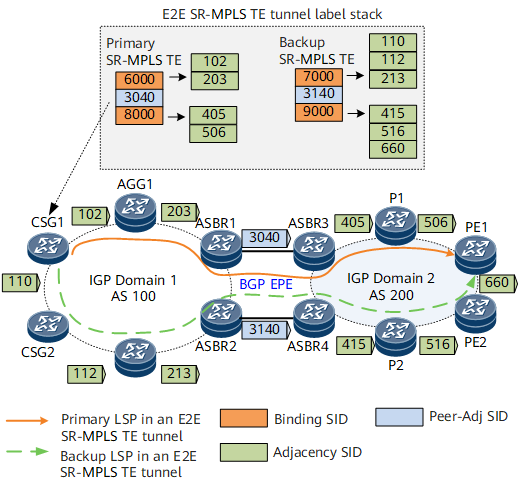Binding SID
Similar to RSVP-TE tunnels, SR-MPLS TE tunnels can be used as forwarding adjacencies. If an SR-MPLS TE tunnel is used as a forwarding adjacency and assigned an adjacency SID (Adj-SID), the Adj-SID identifies the SR-MPLS TE tunnel and is used to import data traffic into the SR-MPLS TE tunnel, implementing a TE policy. The Adj-SID of the SR-MPLS TE tunnel is called a binding SID. Traffic that uses the binding SID is bound to an SR-MPLS TE tunnel or a TE policy.
- Set binding SIDs to 6000 and 7000 on CSG1, representing label stacks {102, 203} and {110, 112, 213}, respectively.
- Set a binding SID to 8000 on ASBR3 to represent a label stack {405, 506}.
- Set a binding SID to 9000 on ASBR4 to represent a label stack {415, 516, 660}.
After binding SIDs are generated, the controller can calculate an inter-AS E2E SR-MPLS TE tunnel using the binding SIDs and BGP peer SIDs. A static explicit path can be configured so that an inter-AS E2E SR-MPLS TE tunnel is established over the path. In Figure 1, the label stacks of the primary and backup LSPs in an inter-AS E2E SR-MPLS TE are {6000, 3040, 8000} and {7000, 3140, 9000}, respectively. The complete label stacks are {102, 203, 3040, 405, 506} and {110, 112, 213, 3140, 415, 516, 660}.
A binding SID is associated with a local forwarding path by specifying a local label, and is used for NE forwarding and encapsulation. Using binding SIDs reduces the number of labels in a label stack on an NE, which helps build an inter-AS E2E SR-MPLS TE network.
